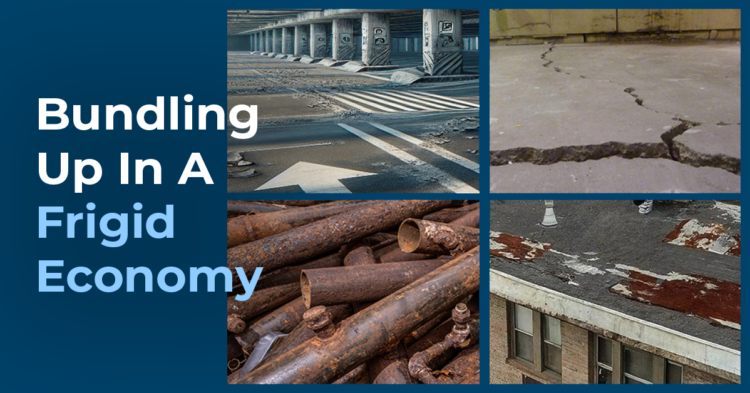Let’s face it, the current economic climate is a bit chilly. Interest rates are higher than they have been in years, inflation is eating into our paychecks, and in the post-COVID world, everything seems to come with a price premium. So, what did mom always tell you to do when it was cold outside? Bundle Up. Of course, she meant a coat, warm hat, and mittens, but in today’s frigid economy, bundling your community’s capital improvement projects into a single loan may be equally good advice!
Why Bundling Is Sometimes Necessary
As communities age, they are in constant need of repairs, and sometimes upgrades, to help maintain residents’ quality of life and protect owner investments. Often, you don’t get to choose when a project is required. If an elevator breaks, for example, you’re required to repair it immediately. Many projects, however, are more predictable. You know approximately how long certain components of your community buildings will last so you can plan ahead for when to replace them. Plumbing systems are a good example. A domestic supply piping system generally reaches the end of its useful life after 30–50 years, and your community will start to experience more frequent and severe leaks when the system approaches its actual expiration date.
Even when you plan ahead for significant repairs and replacement that your community might require, projects can start to add up and include plumbing and mechanical systems, cement spalling, lobby and hallway renovations, a new pool deck, a new roof, balcony repair…the list can go on. Some of these capital improvement projects may be fully or partially covered by reserves, and others may require a loan or special assessment.
Why Bundling Make Sense
If you have multiple projects on the horizon in your community, bundling them for a single loan may be a great solution. Why? Well, if your community finances are in good shape and you go to the bank today to ask for a loan to fund a single project, they are likely to give it to you. If you go back next year for another loan, for another project, it may be harder to qualify because of your existing outstanding debt. Fast forward three or four years, and with multiple loans for multiple projects, you may not be able to borrow at all, forcing your community to pay out of pocket or defer an important project.
By showing banks that you have strategically planned ahead, they are more likely to loan you the money you need to cover multiple projects in a single, larger loan. This is because it’s more advantageous for banks to issue large loans—e.g., bigger interest payments—and less risky because they view communities with strategic plans as less likely to default.
A single loan can be better for the community too, because you’ll get all the funding you need for multiple projects without opening the community to repeated conversations or votes about how to fund each project individually. In addition, you may be able to lower or eliminate special assessments for the covered projects and perhaps reduce untenable spikes in monthly assessment fees. That’s because you’ll likely reduce operational costs due to things like fewer repairs and lower insurance costs, and you’ll have a single, predictable, long-term repayment schedule that facilitates more reliable financial planning. Of course, completing needed projects in a timely way also helps maintain and may even improve owners’ unit values.
What Can You Do Before Approaching Your Bank?
Before approaching banks about a single bundled loan, prepare a defined scope for all your project needs. The Board or a committee can work with its community manager to obtain bids, prioritize projects, and create a plan for how to phase the work over time.
In fact, this kind of planning is similar to how apartment communities operate. For example, when a REIT acquires a new apartment community to add to its portfolio, it comes up with a 5-to-10-year capital improvement plan and creates a budget for all the projects that need to be completed during that time. If a project is not on the list, chances are it’s not getting funded because it wasn’t part of the original financial model for capital expenditures.
So, if your community is looking at some much-needed repairs and renovations, think big and consider bundling multiple capital improvement projects into a single loan to make sure you have the resources you need to keep your community running at its best.



